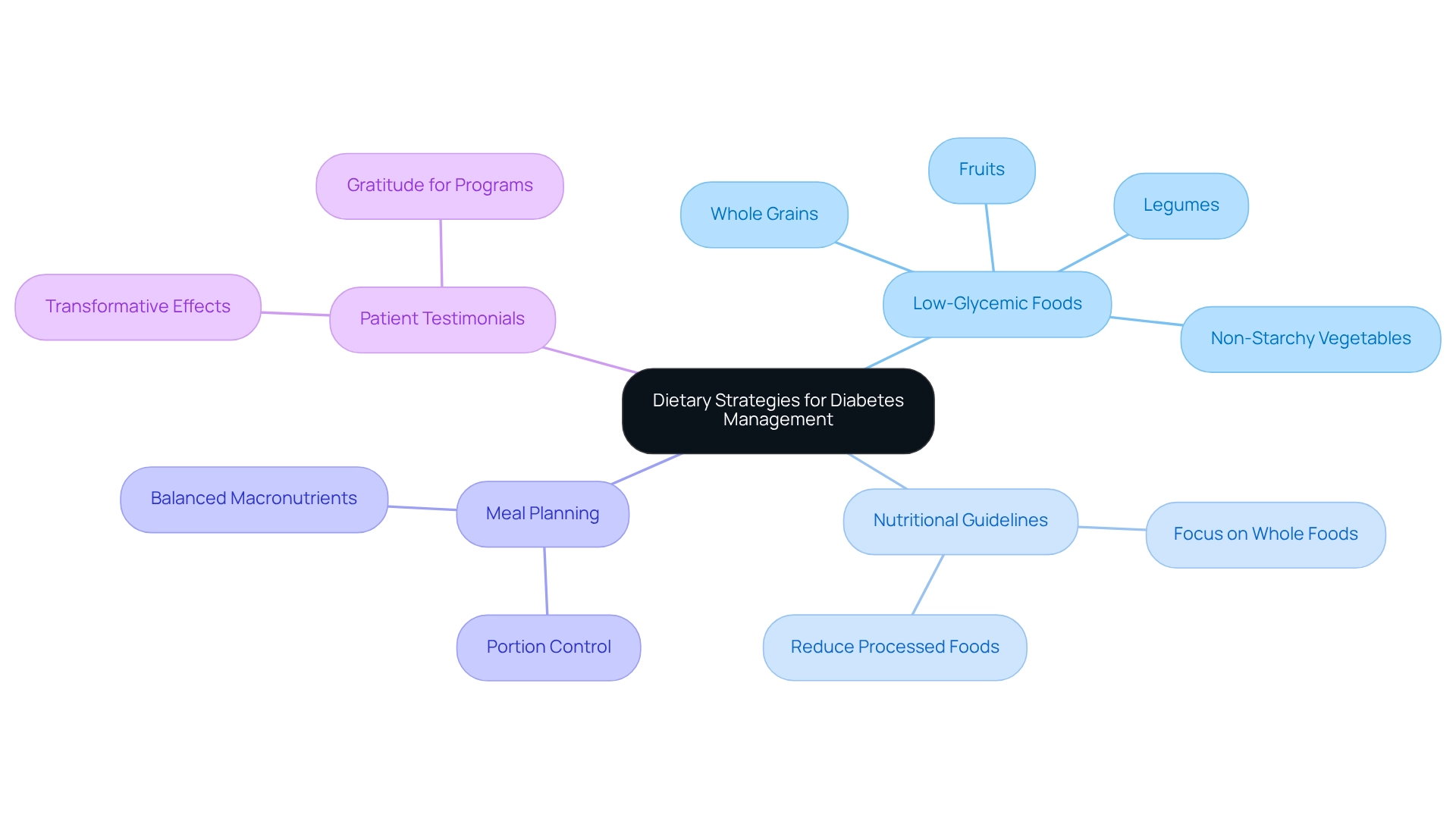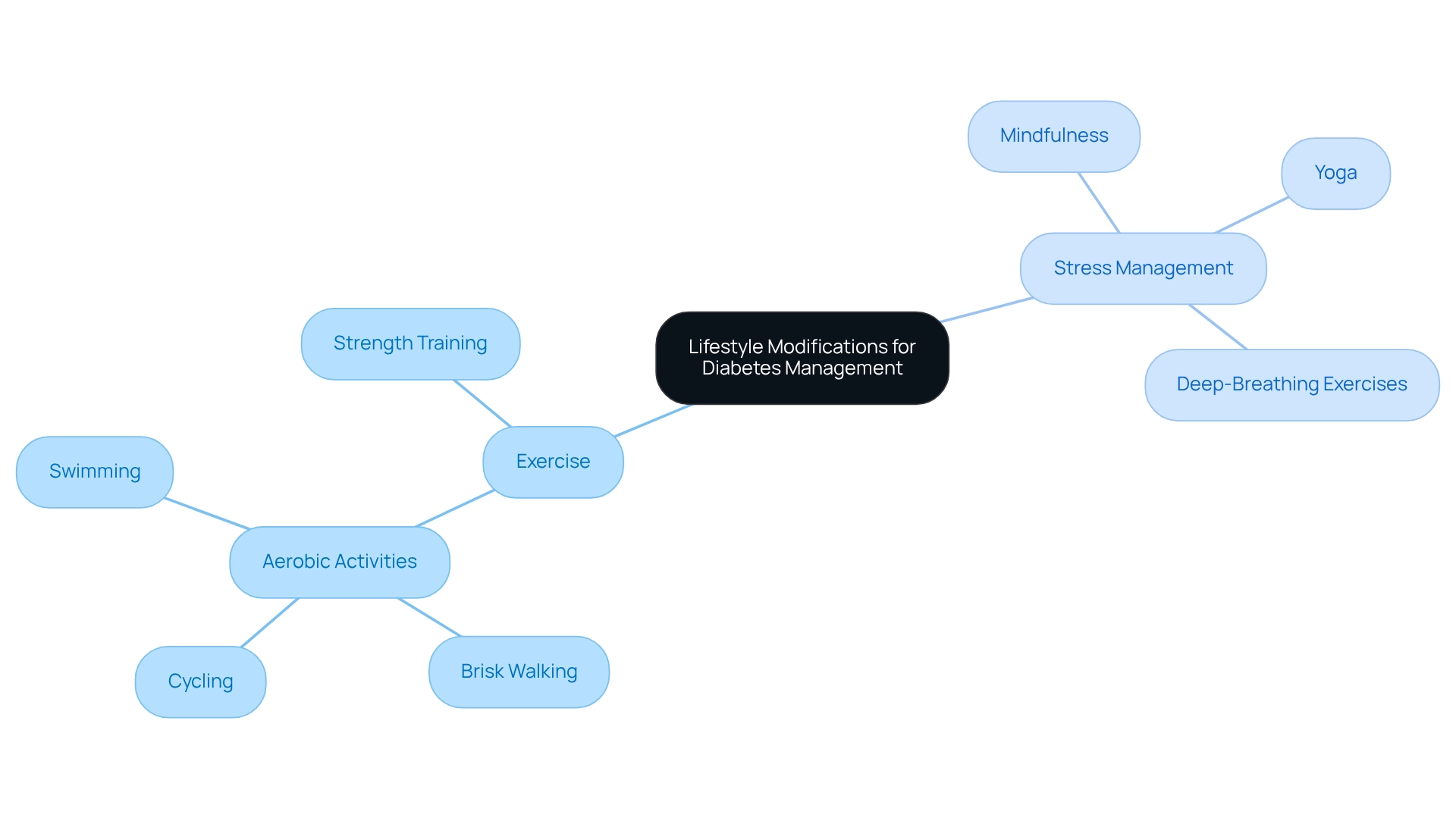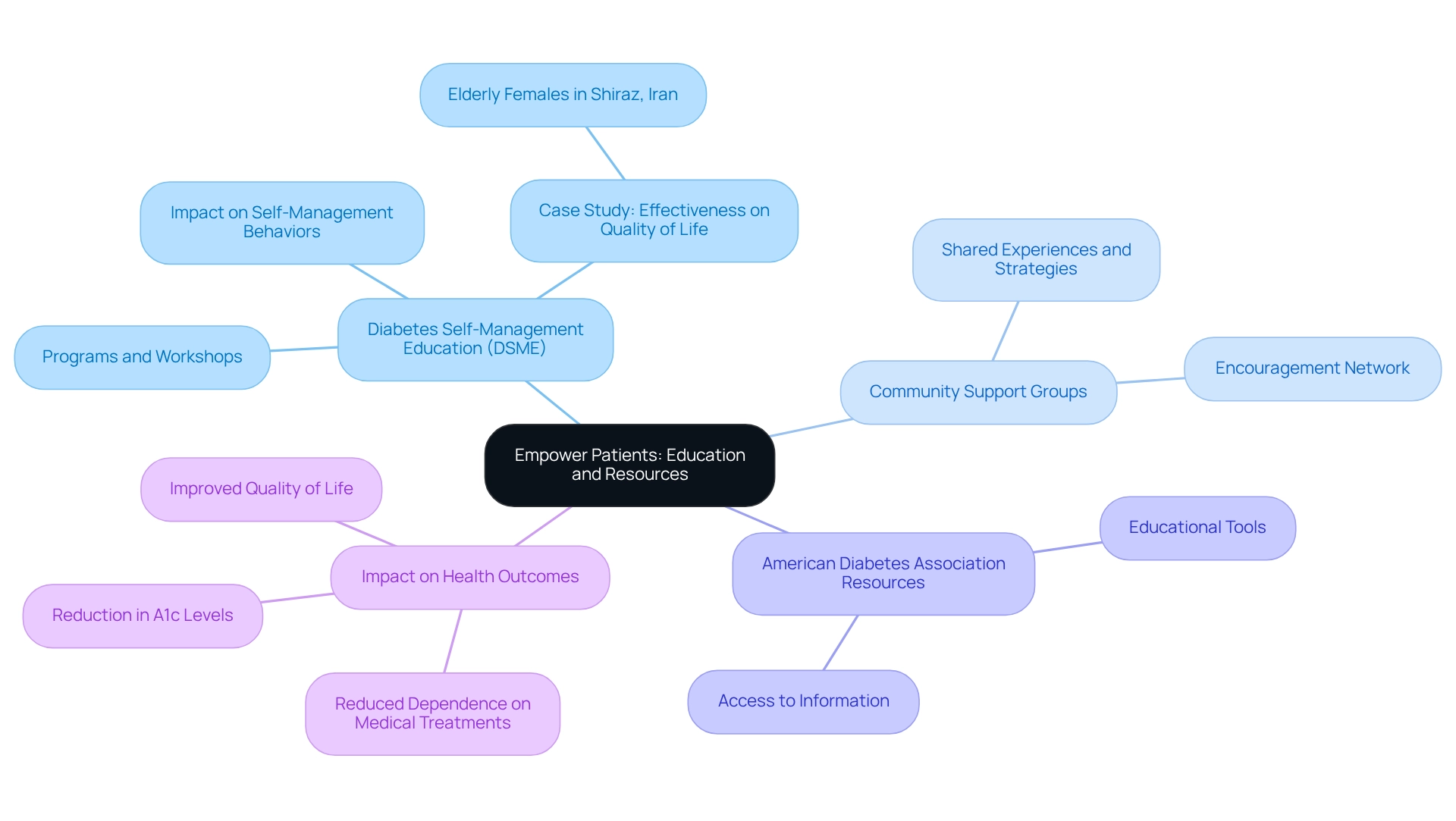Overview
Managing Type 2 diabetes mellitus can feel overwhelming, but there are four essential practices that can make a significant difference in your journey. These include:
- Adopting a low-glycemic diet
- Engaging in regular physical activity
- Implementing stress management techniques
- Empowering yourself through education
It’s important to recognize that these practices not only enhance blood sugar control but also improve your overall health and foster valuable self-management skills.
Many patients find that by embracing these practices, they can take charge of their health in a meaningful way. Imagine feeling more energetic and confident as you navigate your daily life. This collective approach to managing diabetes encourages a sense of empowerment and well-being.
As you consider these practices, remember that you are not alone. With the right support and resources, you can effectively manage your condition and lead a fulfilling life. The 30-Day Diabetes Reset program is designed to guide you through this transformative journey, helping you to embrace a healthier lifestyle with compassion and understanding.
Introduction
The growing prevalence of type 2 diabetes presents a significant challenge to global health, affecting millions who face this chronic condition. It’s important to recognize the struggles that come with managing diabetes. Understanding the underlying causes and recognizing the symptoms are crucial first steps in combating this epidemic. Many patients find that lifestyle factors, such as obesity and sedentary habits, along with dietary choices that influence blood sugar levels, contribute to their challenges. The complexities of diabetes management require a multifaceted approach.
By incorporating effective dietary strategies, engaging in regular physical activity, and practicing stress management techniques, individuals can take control of their health. Empowering patients through education and community support further enhances their ability to navigate this condition. Imagine the difference it could make in your life by having a supportive network and the right tools at your disposal. This nurturing approach paves the way for improved quality of life and better health outcomes. Together, we can work towards a healthier future.
Understand Type 2 Diabetes: Causes and Symptoms
Mellitus diabetes type 2 can feel overwhelming, as it develops when the body becomes resistant to insulin or when the pancreas has difficulty producing enough insulin. Common symptoms, such as increased thirst, frequent urination, fatigue, and blurred vision, can significantly impact daily life. Recognizing these symptoms is crucial for early identification and timely medical intervention. Many people find that the gradual emergence of these symptoms often leads to postponed diagnosis, which underscores the importance of raising awareness about mellitus diabetes type 2.
Additionally, lifestyle choices play a significant role in the onset of mellitus diabetes type 2. Factors like obesity, sedentary behavior, and poor dietary choices can increase the risk. Did you know that 81% of adults living with this condition reside in low- and middle-income nations? This statistic highlights the global impact of lifestyle-related factors. Additionally, individuals diagnosed with type 2 diabetes face medical expenses that are 2.6 times greater than those without the condition, emphasizing the financial strain that can accompany delayed diagnosis and oversight.
It’s important to recognize that integrating stress-relief methods into daily life can be a game changer for managing diabetes. Physical exercise, sufficient rest, and relaxation activities are essential for effective oversight of the condition. Case studies show that managing stress can greatly improve outcomes for those with diabetes, motivating them to seek guidance from healthcare providers. By understanding the causes and signs of mellitus diabetes type 2, individuals can take proactive steps toward prevention and management, ultimately improving their health and enhancing their quality of life.
Implement Dietary Strategies: Low-Glycemic Foods and Nutritional Guidelines
Managing mellitus diabetes type 2 can be challenging, but incorporating a diet rich in low-glycemic foods is a vital step toward effective blood sugar control. Foods like whole grains, legumes, fruits, and non-starchy vegetables are digested slowly, leading to a gradual rise in blood sugar levels. It’s important to recognize that the American Diabetes Association encourages focusing on whole foods, suggesting a reduction in processed items that are high in sugar and refined carbohydrates. For instance, incorporating sweet potatoes, lentils, and leafy greens not only provides essential nutrients but also supports stable glucose levels.
Meal planning that emphasizes portion control and balanced macronutrients can significantly enhance adherence to dietary guidelines, helping patients manage their condition more effectively. Many patients find that recent studies highlight the positive impact of dietary changes on blood sugar levels, with low-glycemic foods showing promising results in minimizing postprandial glucose spikes. Nutritionists often emphasize that adopting low-glycemic diets can be particularly beneficial, serving as a complementary strategy alongside traditional treatments. Dr. Jason Shumard, a leader in functional medicine at Integrative Wellness Center, observes, ‘As these benefits are observed beyond simultaneous treatment with hyperglycaemia medications or insulin, low GI/GL dietary patterns may be particularly beneficial as supplementary treatment to assist those with type 1 and mellitus diabetes type 2 in reaching their goals for glycaemic control and cardiometabolic risk factors.’
Furthermore, testimonials from individuals at Integrative Wellness Center illustrate the significant impact of the center’s programs on their wellness, showcasing the effectiveness of these dietary approaches. By focusing on these dietary strategies, individuals can take proactive steps toward improved well-being and a better quality of life. If you’re eager to learn more about how Dr. Shumard can assist you in restoring your health, consider calling 858-564-7081 or registering for our next event to gain valuable resources and support.
Adopt Lifestyle Modifications: Exercise and Stress Management Techniques
Regular physical activity is vital for effectively managing mellitus diabetes type 2 conditions, as it enhances insulin sensitivity and helps regulate blood sugar levels. It’s important to recognize that the American College of Sports Medicine recommends engaging in at least 150 minutes of moderate-intensity aerobic exercise each week. Activities such as brisk walking, cycling, and swimming can be particularly beneficial. Furthermore, many patients find that including strength training workouts at least twice weekly greatly enhances metabolic health.
Current recommendations highlight the significance of physical activity not only for weight control but also for overall wellness. For instance, the Look AHEAD trial emphasized that participants who aimed to shed more than 7% of their starting weight and increased their moderate physical activity to over 175 minutes weekly experienced significant wellness enhancements. Additionally, stress reduction strategies—such as mindfulness, yoga, and deep-breathing exercises—are essential elements of managing blood sugar levels. Research shows that effective stress reduction can lead to improved blood glucose control. Individuals are encouraged to explore various stress-relief strategies to find what works best for them, as managing stress is integral to maintaining optimal health.
Before starting new physical activities, consulting healthcare providers is advisable to ensure safety and appropriateness based on individual health conditions. This method not only lowers the chance of injury but also encourages informed choices about physical activity, ultimately aiding in effective health control. Remember, you are not alone in this journey, and taking these steps can lead to a healthier, more fulfilling life.
Empower Patients: Education and Resources for Effective Diabetes Management
Empowering patients through education is essential for effectively managing mellitus diabetes type 2. Diabetes self-management education (DSME) programs, workshops, and support groups equip individuals, particularly those with mellitus diabetes type 2, with the knowledge and skills necessary to navigate their condition. Many patients find that these programs significantly boost their understanding and self-management behaviors, leading to an improved quality of life.
For instance, a study on older women with mellitus diabetes type 2 revealed that involvement in DSME greatly enhanced their overall well-being. It’s important to recognize that organizations such as the American Diabetes Association offer a wealth of educational resources and tools for those managing mellitus diabetes type 2. These resources allow patients to better comprehend their condition and make informed choices regarding their care.
Participating in community events and seminars cultivates a supportive atmosphere where individuals can share experiences and strategies, further enhancing their leadership abilities. The influence of community support groups is profound; they establish a network of encouragement and shared knowledge that is essential for ongoing health advancements.
By providing patients with the appropriate information and assistance, they can feel more assured in handling their condition. This ultimately leads to improved health outcomes and a decreased dependence on traditional medical treatments. As the landscape of diabetes management evolves, the importance of patient education remains a cornerstone of effective care. Together, we can foster an environment where patients feel empowered and supported on their journey to better health.
Conclusion
Managing type 2 diabetes can feel overwhelming, but it’s important to remember that you’re not alone on this journey. Understanding its causes and symptoms is just the beginning. Early recognition of symptoms allows for timely intervention, leading to better health outcomes. Lifestyle factors like obesity and poor dietary choices play a significant role in this condition, highlighting the need for greater public awareness and proactive measures.
One powerful step you can take is adopting a diet rich in low-glycemic foods. Focusing on whole, nutrient-dense options and mindful meal planning can truly transform your blood sugar management. Many individuals find that combining these dietary changes with regular exercise and stress reduction practices creates a strong foundation for managing their diabetes.
Empowering yourself through education and community support is equally vital. Access to diabetes self-management education programs and resources can help you take control of your health, fostering confidence and independence along your journey. The collective impact of informed choices and community encouragement not only enhances your well-being but also contributes to a broader movement toward improved health outcomes for everyone.
In conclusion, the fight against type 2 diabetes requires a comprehensive approach that integrates knowledge, lifestyle modifications, and community support. By prioritizing education and adopting healthier habits, you can reclaim your health and work toward a brighter, healthier future. Together, these efforts will pave the way for a significant reduction in the burden of diabetes, creating a healthier world for generations to come.
Frequently Asked Questions
What is type 2 diabetes mellitus and how does it develop?
Type 2 diabetes mellitus develops when the body becomes resistant to insulin or when the pancreas has difficulty producing enough insulin.
What are the common symptoms of type 2 diabetes?
Common symptoms include increased thirst, frequent urination, fatigue, and blurred vision.
Why is it important to recognize the symptoms of type 2 diabetes?
Recognizing these symptoms is crucial for early identification and timely medical intervention, as many people may postpone diagnosis due to the gradual emergence of symptoms.
What lifestyle choices can increase the risk of developing type 2 diabetes?
Factors such as obesity, sedentary behavior, and poor dietary choices can increase the risk of developing type 2 diabetes.
What is the global impact of type 2 diabetes?
Approximately 81% of adults living with type 2 diabetes reside in low- and middle-income nations, highlighting the global impact of lifestyle-related factors.
How do medical expenses compare for individuals with type 2 diabetes versus those without?
Individuals diagnosed with type 2 diabetes face medical expenses that are 2.6 times greater than those without the condition.
What role does stress management play in managing type 2 diabetes?
Integrating stress-relief methods such as physical exercise, sufficient rest, and relaxation activities is essential for effective management of the condition.
How can individuals take proactive steps toward prevention and management of type 2 diabetes?
By understanding the causes and signs of type 2 diabetes, individuals can take proactive steps toward prevention and management, ultimately improving their health and quality of life.



